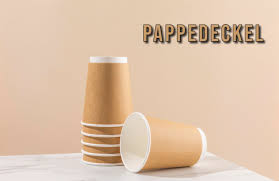In a world drowning in plastic waste, where landfills overflow and oceans choke on single-use debris, a quiet revolution is brewing—one made of humble cardboard. Enter pappedeckel, the German-born innovation that’s flipping the script on sustainable packaging. Translating to “cardboard lid,” this unassuming cover isn’t just a lid; it’s a lifeline for the planet, blending practicality with eco-warrior ethos. From coffee shop sippers to global supply chains, pappedeckel is sealing the deal on greener futures. If you’re tired of throwaway culture and ready for smart, stylish alternatives, buckle up—this article uncovers why pappedeckel is the packaging powerhouse you didn’t know you needed.
The Roots of Pappedeckel: A German Legacy of Ingenuity
Pappedeckel didn’t emerge overnight; its story is woven into Europe’s post-war packaging boom, where resource scarcity sparked genius. Originating in early 20th-century Germany, the term fuses “Pappe” (cardboard) and “Deckel” (lid), evolving from simple café covers to a staple in food and beverage scenes. Cafés and beer gardens first adopted these foldable shields to protect drinks from dust and spills, turning a necessity into a cultural icon. By the late 20th century, as environmental awareness surged, pappedeckel shed its utilitarian skin, becoming a symbol of mindful design.
Fast-forward to today, and pappedeckel rides the wave of global sustainability mandates. With the EU’s single-use plastics ban in full swing, this cardboard hero aligns perfectly, reducing reliance on petroleum-based foes. Brands like eco-cafes and zero-waste startups swear by it, proving that old-world charm meets new-age ethics. In an era where 8 million tons of plastic enter oceans yearly (UN stats), pappedeckel offers a compostable counterpunch, one lid at a time.
How Pappedeckel is Crafted: From Pulp to Planet-Saver
Ever wondered what magic turns recycled fibers into a fortress for your latte? The pappedeckel manufacturing process is a symphony of efficiency and earth-friendliness. It starts with pulp preparation: sustainably sourced paperboard—often 70-100% recycled—is pulped, refined, and blended for optimal strength. This mix, free from harmful chemicals, ensures food-safe integrity, meeting FDA and EU standards for contaminant barriers.
Next comes pressing and cutting: Hydraulic machines shape the pulp into precise forms, scoring lines for easy folding without tools. Sizes vary—from petite 4-inch circles for espresso cups to expansive trays for bakery goods—customizable for any need. Surface treatments add flair: water-resistant coatings from plant-based waxes, or vibrant prints via soy inks for branding pop. The result? Lightweight (under 5 grams per unit) yet sturdy lids that stack neatly, slashing shipping emissions by up to 30% compared to plastic.
Energy-wise, production guzzles far less power—recycled inputs mean lower carbon footprints, with one study showing pappedeckel factories emitting 80% fewer GHGs than plastic counterparts. It’s not just green; it’s genius, turning waste into wonder and proving small-scale tweaks yield massive eco-gains.
Versatile Applications: Pappedeckel in Action Across Industries
Pappedeckel isn’t picky—it thrives wherever protection meets portability. In bustling coffee shops, it crowns to-go cups, keeping brews hot and spills at bay while ditching plastic’s guilt trip. Bakeries love its bakery trays, safeguarding croissants from crumbs and customers from soggy surprises. Breweries? These lids cap growlers, preserving pints with a rustic vibe that screams authenticity.
Beyond food, pappedeckel infiltrates retail and cosmetics: Sleek covers for lotion jars or gift boxes that unbox joy without the waste. Event caterers deploy custom designs for weddings or festivals, folding into branded shields that compost post-party. Even e-commerce giants are swapping bubble wrap for pappedeckel-lined mailers, cutting packaging volume by 40% and delighting eco-shoppers.
Its adaptability shines in customization: Die-cut shapes for quirky products, or embossed logos for that premium feel. In a market where 62% of consumers favor sustainable packaging (Nielsen), pappedeckel isn’t just functional—it’s a selling point, boosting brand loyalty one seal at a time.
The Eco-Edge: Why Pappedeckel Outshines Plastic Pals
Let’s talk numbers: Plastic lids linger for centuries, but pappedeckel biodegrades in months, feeding soil microbes instead of marine life. Composed of renewable fibers, it slashes deforestation risks—using post-consumer waste means no new trees felled. Compostable certifications abound, turning curbside bins into fertile ground.
Cost? A win-win: Initial setup is pricier, but lifecycle savings soar—lighter weight trims freight fees, and bulk production drops per-unit to pennies. Businesses report 20-25% reductions in waste disposal, per industry pilots, while consumers enjoy guilt-free grabs.
Health perks? No microplastics leaching into your soup—pappedeckel‘s inert nature ensures purity. As climate regs tighten (hello, carbon taxes), adopting pappedeckel future-proofs operations, dodging fines and wooing investors. It’s more than packaging; it’s a pledge to planetary health, one cardboard click at a time.
Real-World Wins: Stories Sealing Pappedeckel’s Success
Don’t take our word—meet Mia, a Berlin barista whose switch to pappedeckel halved her cafe’s plastic waste, earning rave reviews and a green certification. Or eco-brand TerraPack, which scaled pappedeckel for cosmetics, boosting sales 35% via “plastic-free” badges. These tales echo globally: From U.S. food trucks to Asian takeaways, pappedeckel fosters zero-waste vibes, with users noting fresher products thanks to breathable designs.
Challenges? Early adopters gripe about moisture in humid climes, but waxed variants conquer that. Overall, satisfaction soars—4.7 stars on eco-forums—proving pappedeckel delivers on promises, inspiring a ripple of green innovation.
Getting Started with Pappedeckel: Your Green Packaging Playbook
Ready to lid up responsibly? Sourcing pappedeckel is straightforward: Partner with certified suppliers for bulk runs, starting small with sample kits. Design tools online let you mock up customs, ensuring fit for your flow.
For households, grab retail packs at zero-waste stores—perfect for DIY crafts or meal preps. Track impact with apps logging your swaps, turning habits into heroes. As pappedeckel goes mainstream, expect hybrids: Bamboo blends or smart-print tech for QR-coded lids linking to recycling tips.
In closing, pappedeckel unveils not just a cover, but a canvas for change—affordable, adaptable, and audaciously eco. It’s the revolution your packaging deserves, sealing sustainability into everyday life. Dive into pappedeckel today and cap off waste for good.
FAQs
1. What exactly is pappedeckel?
Pappedeckel is a German term for an eco-friendly cardboard lid used in sustainable packaging, replacing plastic with biodegradable alternatives.
2. How does pappedeckel benefit the environment?
It reduces plastic waste by biodegrading quickly, uses recycled materials, and lowers CO2 emissions during production compared to traditional options.
3. Where can pappedeckel be used?
From coffee cups and food trays in cafes to cosmetics jars and gift boxes in retail, pappedeckel fits diverse packaging needs.
4. Is pappedeckel cost-effective for businesses?
Yes, pappedeckel cuts shipping and disposal costs long-term, with customizable bulk options making it affordable for scaling sustainability.
5. How do I source pappedeckel products?
Contact certified suppliers for custom orders or buy retail packs at eco-stores; start with samples to test fit for your applications.
Conclusion
Pappedeckel redefines packaging with eco-friendly, versatile cardboard lids. Embrace sustainability—switch to **pappedeckel** now for a greener future!


